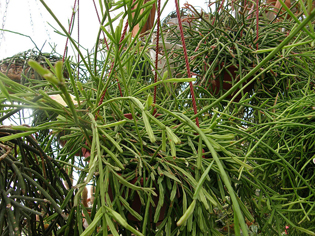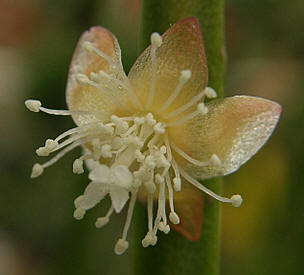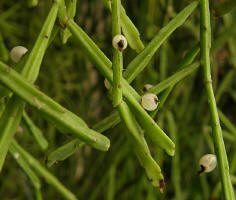|
Rhipsalis sulcata F A C Weber in Bois, Dict. hort. 1046. (1898)
Desc from B&R 1923
Plant - stems woody, sometimes 10 to 15 mm. in diameter, often long and pendent;
Branches - elongated,
the joints 2 to 3 dm. long, 5.angled, light green;
Areoles - remote (2.5 to 5 cm. apart), usually near the center of a purple blotch;
Flowers - solitary at the areoles,
rather large, rotate, white to pinkish;
Ovary - naked.
Type locality: Not cited.
Notes from Bradleya 13
DISTRIBUTION. Brazil (S Espirito Santo): Domingos
Martins.
Until recently this species was
known only in cultivation, where it was often misidentified as R. micrantha (central Andes to Central America). It appears to be a relative of R. pentaptera. Scheinvar (1985) misapplies the name R. sulcata to specimens of R. trigona Pfeiffer emend. Barthlott &
Taylor.
 
%20.jpg) 
Upper left: R. sulcata (Hermann Engelmann Greenhouses), right: R. sulcata (Bonn).
Lower left and right: R. sulcata (Rainbow Gardens)
Desc from Hunt 2006.
Like R. cereoides, but body pendent; basal branch segments up to ca 8-10 mm
diam, new segments arising 2-5 together, up to 25cm x 6-7mm, weakly (3-) 5-
angled, the shortest sometimes almost terete, naked prior to flower bearing
except for minute scales and occasional bristles, the scales upon raised podaria;
flowers ca 1.5cm diam; fruit pinkish.
Somewhat resembling R. floccosa, but with consistently angled branch segments
and less obviously erumpent flower buds leaving only slightly woolly areoles
post anthesis.
Dr. Nigel Taylor says that R. sulcata is known from
only one site but must have come from others, which would account for the variation
in flowers seen here.
|


%20.jpg)
